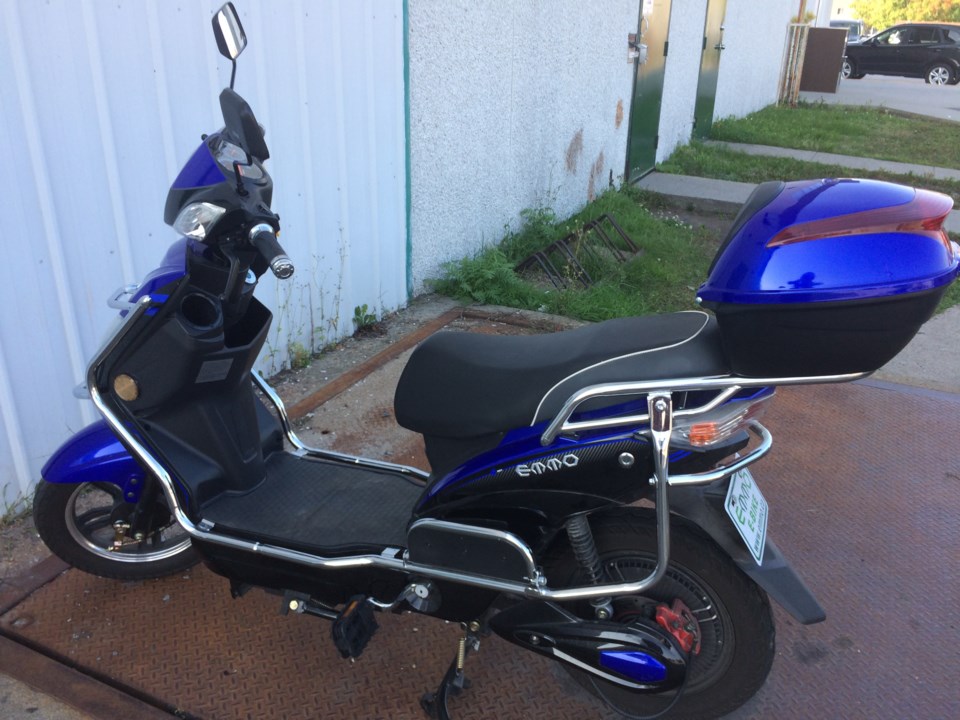OPP is urging all drivers of e-bikes, mobility devices, mopeds, electric scooters, and other alternative forms of transportation, to know the laws before heading out on Ontario roads. With the emerging popularity of these smaller, more economical forms of transportation, it is vital that users understand the rules and regulations governing their use as well as all safety requirements.
The most common type, the e-bike, is defined under the Highway Traffic Act and the Motor Vehicle Safety Act Regulations as a power-assisted bicycle. These vehicles can only have an electric motor and come in two varieties, the e-bike which looks similar to a standard bicycle, and the e-scooter which looks similar to a motor scooter. Vehicles in the e-bike category must:
- have a label affixed by the manufacturer that the vehicle complies with these regulations
- Have steering handlebars
- Be fit at all times with pedals that are operable to propel the bicycle
- Be designed to travel on no more than 3 wheels in contact with the ground
- Not be capable of providing further assistance when the bicycle attains a speed of 32 km/hr
The laws governing their use on roadways include:
- Operator (and any passenger) must be 16 years of age
- Operator (and any passenger) must wear a helmet (may be a bicycle or motorcycle helmet)
- must be equipped with safety devices accordingly (e.g. bell, white front light, red rear light)
- May carry a passenger only if the e-bike is equipped with a second seat and footrests
- Does not require driver's license, permit, license plate or insurance
- Operator must follow all rules of the road that apply to any vehicle or bicycle
- Cannot be operated on a sidewalk
- Are not permitted on controlled-access highways (such as 400-series and others)
- Cannot be operated by anyone under a Criminal Code driving prohibition
Another common vehicle is the motor-assisted bicycle (moped). These are bicycles manufactured with either an attached motor driven electrically or having a piston displacement of not more than 50 cubic centimetres. In addition, these vehicles must:
- Have pedals that are operable at all times
- Weigh no more than 55 kilograms
- Not have sufficient power to attain a speed greater than 50 km/hr
The laws governing their use on roadways include:
- Operator must be at least 16 years of age
- Operator must wear an approved motorcycle helmet
- must be equipped with safety devices accordingly (e.g. bell, white front light, red rear light)
- Operator must have a valid driver's licence (M1, M2 or M, or restricted M2 or M with L endorsement)
- Must have a permit and Moped plate
- Must have insurance
- No passenger allowed
- Are not permitted on controlled-access highways (such as 400-series and others)
Another category of vehicles that are common is the motor scooter or limited speed motorcycle. These vehicles are self-propelled and are designed to travel on no more than three wheels in contact with the ground. These vehicles must:
- Not be equipped with pedals
- Have a maximum engine displacement of 50 cubic centimetres
- Have a maximum speed of 70 km/hr
- Be step-through design with handlebar steering
- Have a manufacturer's plate indicating the vehicle conforms to federal standards and will have a VIN number
The laws governing their use on roadways include:
- Operator must be at least 16 years of age
- Operator must wear an approved motorcycle helmet
- must be equipped with safety devices accordingly (e.g. bell, white front light, red rear light)
- Operator must have a valid driver's licence (M1, M2 or M, or restricted M2 or M with L endorsement)
- Must have a permit and "Limited Speed Motorcycle" plate
- Must have insurance
- A passenger is allowed but must be wearing an approved motorcycle helmet
- Are not permitted on controlled access highways (such as 400-series and others)
Another familiar category of conveyance is the personal mobility device, or wheelchair. Under the Highway Traffic Act, a wheelchair is defined as "a chair mounted on wheels driven by muscular or any other kind of power that is designed for and used by a person whose mobility is limited by one or more conditions or functional impairments." These devices do not require registration, licence plates, a driver's licence, or insurance and people utilizing them are considered pedestrians and, as such, must follow all rules of the road that apply to pedestrians. Wheelchairs and mobility devices are allowed on sidewalks unless restricted by municipal by-laws.
Many of these conveyances are similar in appearance and it may not be immediately obvious which category they fall under. Before purchasing/operating a new type of vehicle, OPP recommends researching requirements for equipment and licensing under the Highway Traffic Act in Ontario and permitted uses in the municipality in which you intend to operate it. If the gas or electric-powered vehicle you are considering does not fall under one of the above-mentioned categories, it will likely be considered a motor vehicle under the Highway Traffic act and will be subject to all applicable laws and regulations including the requirement for registration, licencing, and insurance.
All of the above noted vehicles have one thing in common. They are all defined as motor vehicles under the Criminal Code of Canada and it is a criminal offence to operate any of them while impaired by alcohol or drugs. Driving any of these conveyances while impaired carries the same consequences as driving a motor vehicle impaired including the possibility of a jail sentence, losing your licence, having your vehicle impounded, a monetary fine, and ending up with a criminal record. If you suspect that someone is driving or about to drive impaired by alcohol or drugs, it is important to call 9-1-1 to report it.



